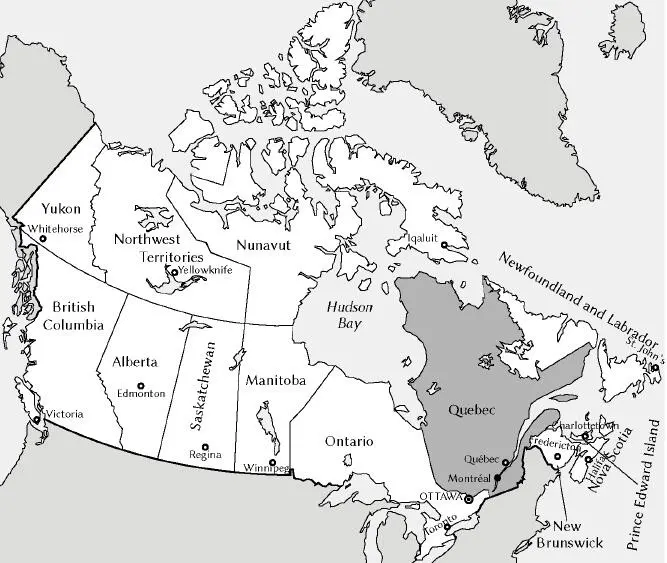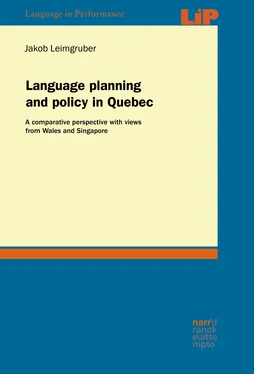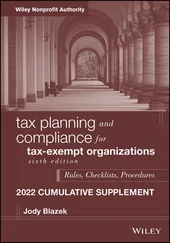1.3 Aims, methods, and structure of the study
This present study aims to offer an insight into the language policies in place in Quebec, by situating them within their larger Canadian, North American, and global context. To that effect, it will, in chapter 6, be compared to two other polities in which the English language has co-existed with other languages for many years. The language policies in place in Wales have the revitalisation of the minority language Welsh as their primary objective, resulting in a situation that has, on occasions, been treated as not being unlike that of French in Quebec. The policies in place in Singapore, on the other hand, have seen much more positive action undertaken to strengthen the use of English, with a decline in linguistic diversity, and even in the vitality of the other official languages, accepted as a collateral effect of shifting towards a language seen as offering more socio-economic opportunities both locally and globally.
In describing the language political situation of Quebec, this study is structured as follows. Chapter 2 begins with the historical background needed to understand the social, demographic, ethnic, and sociolinguistic context in which language use takes place and language policies are developed. A first overview of the major language policy frameworks at the federal and provincial levels is given, with particular emphasis on the situation in Quebec. Chapter 3 gives the theoretical background against which the analysis will take place. General approaches to language policy are presented, as are theories on the global presence of English, with a focus on its use in multilingual settings. In chapter 4, the methodology used for the analysis of language use and policy in Quebec is presented. The data come from four primary sources: a questionnaire survey, a linguistic landscape documentation, ethnographic fieldwork, and psycholinguistic experiments, all of which are then analysed in chapter 5. Chapter 6 undertakes a comparative analysis of the policies operational in Quebec, Wales, and Singapore, drawing on recent theory from the sociolinguistics of globalisation in order to find commonalities, reveal differences, and offer a contribution to the field of comparative language policy in more general. The concluding chapter 7 draws together the results from the preceding chapters and attempts to reevaluate the field of language planning and policy (LPP) in the context of globalisation. It ends with a number of proposals for new ways of analysing LPP.
2 French and English in Canada and Quebec: historical background and language political context
The co-existence, in what is now Canada, of the two languages French and English, goes back to the earliest times of European contact. The competing colonial interests in North America of the two European powers eventually resulted in a significant number of settlers from both language groups, supplemented, of course, with speakers of other languages. However, the long period of French rule, followed by a longer period of British rule, ensured that speakers of other languages converged to either one of these two main languages. The British North America Act 1867 made both languages official, thereby reinforcing this trend and preparing the road for future bilingual policies.
Nowadays, Canada has two official languages. This official bilingualism, however, is constrained by the country’s federal structure: individual provinces and territories may have their own language policies, whereas at the federal level, bilingualism may be implemented slightly differently across the country. The two levels of governance – federal and provincial – are crucial to the understanding of Canadian language policy, particularly so with respect to Quebec, the only province where French is the majority language.
Before European contact, and to a large extent still today, the Canadian part of the North American continent was peopled by a diverse range of ethnic and linguistic groups. Some of the language families found in this vast area are (from east to west) Algonquian, Iroquoian, Eskimo-Aleut, Siouan, Na-Dené, Salishan, and Wakashan (see Lewis et al. 2016 for an overview of the languages on the North American continent). The northern half of the country has always been sparsely populated, with speakers of Eskimo-Aleut settling primarily in coastal communities. The western seaboard of British Columbia, blessed with a more temperate climate, exhibits higher linguistic diversity; ample food supply, in the form of ‘a never-ending supply of fish’, primarily salmon (Bothwell, 2007, 7), enabled the emergence of wealthy cultures with distinct internal social stratification.
Pre-Columbian European contact took place when Norse expeditions to the eastern Canadian shore began under the leadership of Leif Eriksson. These travels, via Iceland, Greenland, and Baffin Island (the presumed location of the Norse Helluland ), resulted in the founding, around the year 1000, of a settlement in L’Anse aux Meadows, on the island of Newfoundland (now a listed National Historic Site of Canada in the province of Newfoundland and Labrador). This settlement, which Ingstad and Stine Ingstad (2000) consider to be the historical Vínland of old Icelandic sagas, did not last long: contact with the local indigenous population, called Skrælings by the Norse and presumed to be Dorset Eskimos (the only Inuits to have lived south of the treeline, see Bothwell, 2007, 9), was rough enough to persuade the Vikings to leave for good again after some years. The Norse may have gone back to harvest timber from a place called ‘Markland’ in the sagas, with Icelandic records mentioning, as late as 1347, a ship returning from this place that has been speculated to have been located on the Labrador coast (Seaver, 1996).

Figure 2.1: A map of Canada showing Quebec.
The received wisdom is that Canada was left untouched by Europeans for two centuries thereafter, until Columbus’ 1492 crossing of the Atlantic. There is some evidence, however, that Portuguese and Basque fishing expeditions kept the transatlantic route open, with some Basque records ‘point[ing] towards their having made contact with Newfoundland in the 1370s’ (Forbes, 1993, 20). In any case, Columbus’ arrival in the Caribbean and, later, to South and Central America, did not impact the much more northerly regions that would later become Canada.
It was later, in 1497 and 1498 that John Cabot, sailing under British commission, began exploring the region around Newfoundland, but without making further inroads into the Gulf of Saint Lawrence. The Portuguese also laid claim to an area around Newfoundland and Nova Scotia in the early sixteenth century, with the explorer João Fernandes Lavrador giving his name to Labrador (Rorabaugh et al., 2004). The few Portuguese settlements established there, however, did not last long. It was the French colonial expansion, beginning with Jacques Cartier’s landing in 1534, that was to have a lasting impact on the continent. From the first cross planted on the Gaspé peninsula to the later settlements along the Saint Lawrence River, Cartier’s ships sailed up the river all the way to the rapids around present-day Montreal and its ‘Mont Royal’.
French explorers and adventurers created alliances with aboriginal peoples, using their local expertise in geography, and establishing trading links (especially for fur) along a complex network that would be crucial for the eventual colonisation of the entire land. Unlike the Spanish expeditions to South America, contact was not entirely hostile and bent on the stealing of natural resources (the area had little gold, and fur did not have the same appeal in Europe; rich fishing grounds were the main attraction), with Cartier’s landing party even being helped over the winter of 1535–1536 by the Iroquois of Hochelaga (Montreal), whom Bothwell (2007, 18) considers ‘hosts’ reasonably well-disposed towards their ‘guests’. Later, more permanent settlements were established by Samuel de Champlain in Port-Royal in 1605 (in the colony of Acadia, now Annapolis Royal in Nova Scotia) and the city of Québec in 1608. Paul de Chomedey, Sieur de Maisonneuve founded Montreal in 1642. These areas, collectively claimed for the French crown and named New France, extended, by the early eighteenth century, from Acadia over the Great Lakes and the prairies of Saskatchewan to Louisiana and the Mississippi Delta in a giant arc, largely leaving the Atlantic seaboard to British colonial interests, where major settlement took place (Jamestown in 1607, Boston 1620).
Читать дальше













